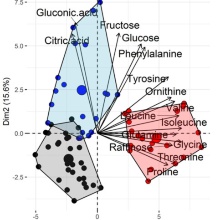Stress responses in plants imply spatio‐temporal changes in enzymes and metabolites, including subcellular compartment‐specific reallocation processes triggered by sudden changes in environmental parameters. To investigate interactions of primary metabolism with abiotic stress, the gin2‐1 mutant, defective in the sugar sensor hexokinase 1 (HXK1) was compared to its wildtype Landsberg erecta (Ler) based on time resolved, compartment specific metabolome and proteome data obtained over a full diurnal cycle. The high light sensitive gin2‐1 mutant was substantially delayed in subcellular redistribution of metabolites upon stress, and this correlated with a massive reduction in proteins belonging to the ATP producing electron transport chain under high light, while fewer changes occurred in the cold. In the wildtype, compounds specifically protecting individual compartments could be identified, e.g. maltose and raffinose in plastids, myo‐inositol in mitochondria, but gin2‐1 failed to recruit these substances to the respective compartments, or responded only slowly to high irradiance. No such delay was obtained in the cold. At the whole‐cell level, concentrations of the amino acids, glycine and serine, provided strong evidence for an important role of the photorespiratory pathway during stress exposure, and different subcellular allocation of serine may contribute to the slow growth of the gin2‐1 mutant under high irradiance.
| Contact | https://doi.org/10.1111/tpj.14491 |
|---|


